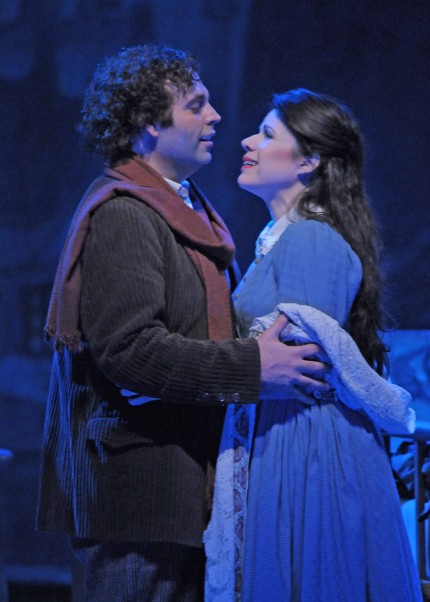Rough edges, hapless direction detract from worthy vocal moments in Lyric Opera’s “Bohème”

Dimitri Pittas and Ana Maria Martinez in the Lyric Opera of Chicago’s “La Bohème.” Photo: Dan Rest
It was even easier to empathize with the impoverished young artists in the freezing Paris garret than usual Monday night. With harsh winter winds and subzero temperatures on Chicago’s coldest night in two years, Mimi wasn’t the only one whose hands needed warming.
The Lyric Opera of Chicago opened its extended two-cast run of La Bohème Monday night at the Civic Opera House. Inevitably, most focus is on the March dates when Anna Netrebko will make her belated Chicago debut as Mimi (with Joseph Calleja as Rodolfo).
If not quite as starry, the January-February lineup looked promising on paper, with Ana Maria Martinez and Dimitri Pittas in his company bow, backed by a solid supporting cast in Puccini’s beloved romantic crowd-pleaser.
Yet despite some worthy vocal moments, Monday’s opener was a decidedly mixed affair that never caught fire, undone by a lack of vocal consistency and dramatic intensity, and stage direction that could charitably be called provincial.
For these performances, Lyric has retired its ancient traditional production and borrowed San Francisco Opera’s less-ancient traditional production. As it turned out, the scenic design was one of the evening’s more consistent elements. Michael Yeargan’s sets offered a genuinely claustrophobic garret for the outer acts—the walls gliding out as Rodolfo declares his love for Mimi in O soave fanciulla—an attractive street scene and wood-paneled Cafe Momus, and evocative, very snowy setting for Act 3. Aided by Walter Mahoney’s dead-on period costumes and Duane Schuler’s painterly chiaroscuro, the production provided ample eye candy.
Vocally and dramatically, however, this was an uneven Bohemian bag. Ana Maria Martinez’s attractive soprano is not a natural Puccini voice, and the singer lacks the opulence of tone to really open up luxuriantly at the big climaxes. She was most effective in the intimate moments, with her lovely and affecting D’onde lieta usci the evening’s clear highlight, and Martinez brought sensitive vocalism and subtle characterization to the final act.
Dimitri Pittas has received positive advance notices in a role he has performed at the Met. The New York native possesses a vibrant tenor with a notably warm, rich mid-range. Unfortunately, Pittas’s voice is weak on top where he often sounded strained, sliding up to a less-than-heroic high C in Che gelida manina.
More problematic was the young tenor’s lack of dramatic incisiveness. Pittas isn’t much of an actor and looked and sounded tentative and ill at ease in Act 1, virtually staring a hole through conductor Emmanuel Villaume. He appeared to grow in confidence as the performance unfolded but considering Pittas’s advance notices, this was hardly an auspicious debut.
Elizabeth Futral made a plucky and attractive Musetta, though her light soprano now sounds distinctly underpowered for the role, her unevenly projected singing at times inaudible in the Act 3 quartet.
As Marcello, Lucas Meachem wound up stealing the show and providing the most satisfying all-around performance both vocally and dramatically. Singing easily with a big, ripe baritone, Meachem was vocally faultless and a natural actor, hilarious in his frustration and rage-eating over Musetta’s flirtatious antics.
Having Andrea Silvestrelli as Colline is luxury casting indeed. The towering Italian bass’s huge voice has undeniable wear, but his artistry and true Italianate sonority more than made up the balance in an idiomatic, deliciously nuanced Vecchia zimarra.
In this fast company, the Schuanard of Ryan Center member Joseph Lim was serviceable but felt a bit pale next to his veteran live-wire companions. Dale Travis brought well-rounded individuality to the dual roles of Benoit and Alcindoro. The ensemble singing, directed by guest chorusmaster Ian Robertson, was magnificent.
The biggest problem with this performance was Louisa Muller’s stage direction, which ranged from awkward to abysmal. Most of her fresh ideas were bad ones and the inept blocking of the Bohemian scenes and lazy, chorus-at-the-footlights handling of Act 2 looked like amateur hour. The staging offered an object lesson in how to dilute crucial dramatic moments: not pausing the action for Silvestrelli to get some well-deserved applause after his Act 4 aria; the stiff immobility of Marcello and Musetta at the climax of Act 2; and having Pittas play busily with Mimi’s bonnet at the final curtain.
The performance also looked underrehearsed with several glitches, from Benoit’s knock accidentally opening the door to Musetta’s entrance coming several seconds too early in Act 4. The pedestrian supertitles didn’t help, often reading like they were designed with a fifth-grade audience in mind
An even greater drag on the performance—literally in the first two acts—was Villaume in the pit. The conductor has been a reliable hand in French repertoire at Lyric but sounds out of his element in Puccini, dragging tempos and dawdling at ends of phrases, which sacrificed forward momentum and led to some miscoordination with the singers. Even the Lyric Opera Orchestra had an off night with some jarring flute and horn lapses.
The current cast of La Boheme runs through Feb. 7. Anna Netrebko and Joseph Calleja will sing the principal roles March 9-28. lyricopera.org; 312-332-2244.